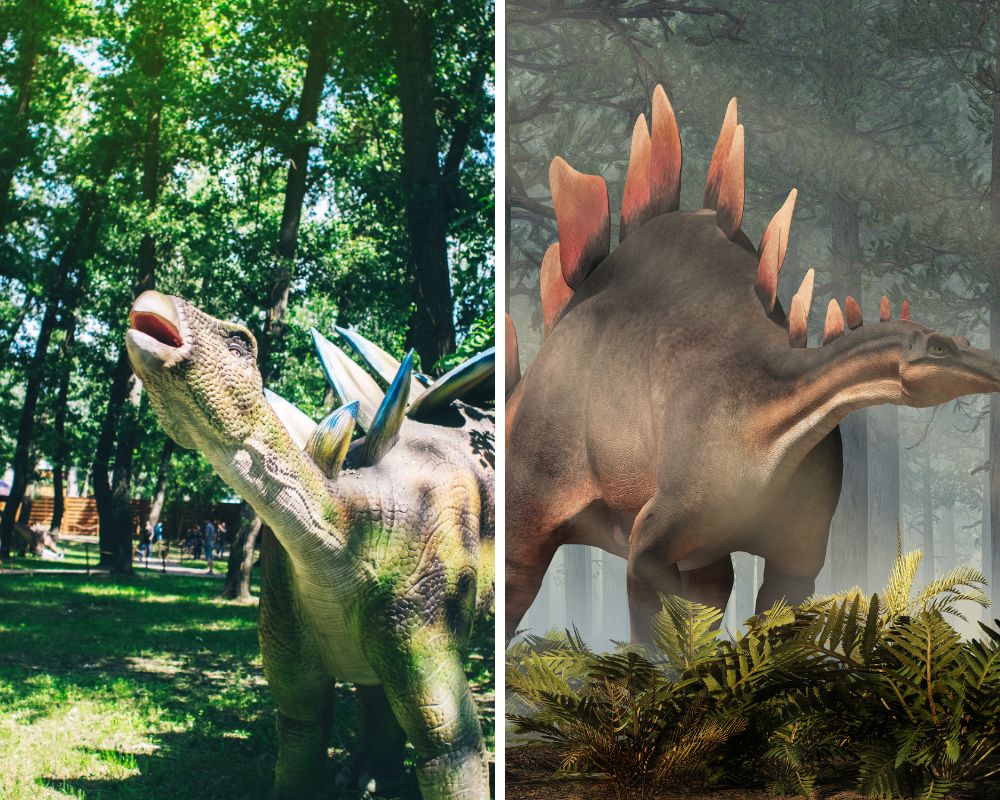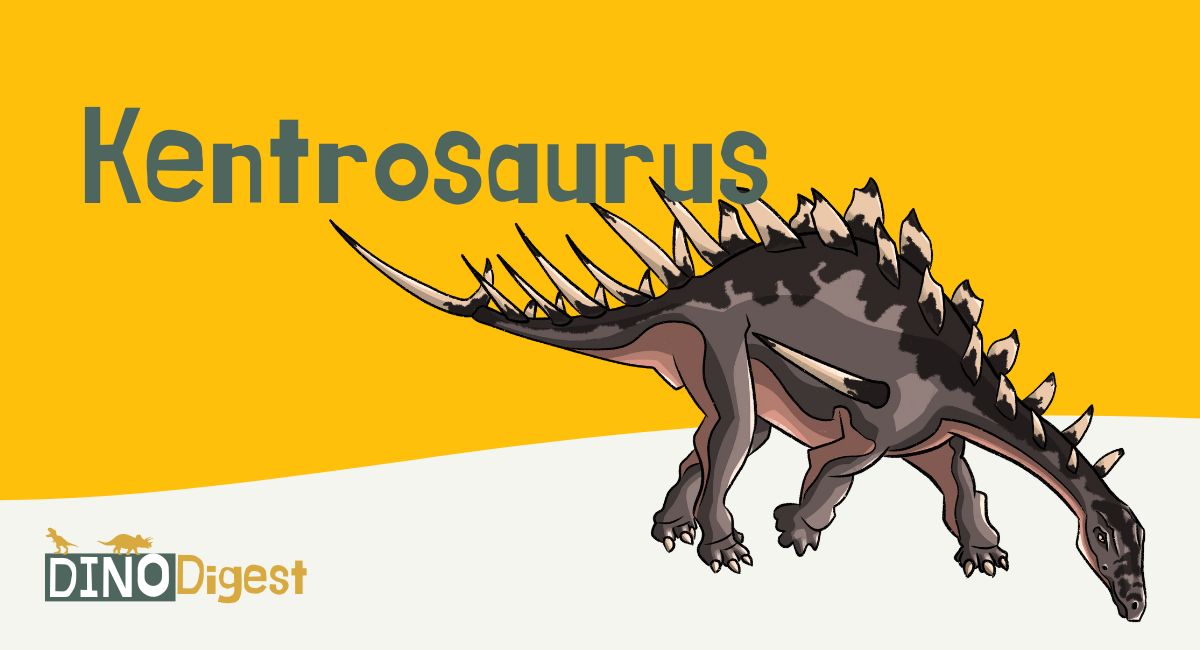The Kentrosaurus was a Stegosaurian dino with plates and spikes on its body. The plates ran from the back of the head to the mid-spine and were said to regulate body heat. Long spikes protected the Kentrosaurus from predators.
Table of Contents
Some Quick Facts about the Kentrosaurus

| Name | Kentrosaurus (means “Prickle Lizard”) |
| Type of dinosaur | Ornithischia |
| Territory | Wetland areas along the coastline with heavily forested inland spaces, Tanzania, East Africa |
| Size | On a larger side, 13-15 feet long, 4-6 feet tall |
| Color | Scaly and Bumpy with hard plates and long spikes along the spine |
| Interesting Characteristics | Super small head, long neck, long spikes sticking out from the shoulders, bony plates from head to mid spine, and a double row of long spikes from mid spine to tail. |
| Diet | Herbivore |
| Major Threats | Large carnivores and Natural Disasters |
The Kentrosaurus was a type of Stegosaur and a close relative of the Stegosaurus. This spiky dino had protective plates along its spine and long spikes on the front legs and hind legs. The spikes on its tail were called thagomizers, which was a term made up by comic strip writer Gary Larson.
He jokingly called the tail spikes a thagomizer in one of his Far Side comics and the name stuck!
What is the difference between a Kentrosaurus and a Stegosaurus?

A Kentrosaurus was much smaller than a Stegosaurus. Compared to the Stegosaurus’s 14-foot height and up to 30-foot length, the Kentrosaurus was about half the size of the mighty Stegosaurus.
A Stegosaurus’ body weight also topped out at a massive 14,000 pounds, around four times the weight of a Kentrosaurus! But there are a few other differences between these two similar dinos that will help you tell them apart.
Both the Kentrosaurus and Stegosaurus used their thagomizer to slash predators, but a Kentrosaurus’ entire tail was covered with long spikes and only the tip of Stegosaurus’s tail had spikes. A Kentrosaurus also had long spikes sticking out from its front legs, which kept predators from ambushing them from the side.
Many paleontologists believe that the Kentrosaurus also had a single long spike protruding from its hind legs. But that fact is still debated.
What Type of Dino Was a Kentrosaurus?
The Kentrosaurus was an herbivorous dinosaur that walked on four legs. They were very slow dinos, with a maximum speed of only 5 miles per hour. Kentrosaurus was pretty short for the time period and grazed on low-lying plants. Fossil evidence suggests that Kentrosaurs lived in large herds.
Kentrosaurus fossils were discovered during an expedition led by Werner Janensch from 1909 to 1912. Paleontologist Edwin Hennig named the Kentrosaurus in 1915.
In 1916, there was some controversy because the name Kentrosaurus was so close to a 1902 dinosaur Canadian discovery that had been named Centrosaurus. Edwin Hennig offered Kentrurosaurus as an alternate. Since the two names were pronounced differently, Kentrosaurus was allowed to keep its name.
Kentrosaurs have only been found in the Tendaguru Formation of Tanzania, along with quite a few other specimens. A total of 1200 bones were found, which paleontologists believed made up about 50 dinos. Unfortunately, a lot of those bones were destroyed in World War II. But there are still some specimens left in the Natural History Museum in Berlin, Germany.
What Preyed on the Kentrosaurus?
The Kentrosaurus’ main predators were the Allosaurus and Ceratosaurus. Both the Allosaurus and Ceratosaurus were massive Jurassic theropods, though neither was as big as the T. rex. A T. rex wasn’t a threat to Kentrosaurus since it lived in the Cretaceous period, long after the Kentrosaurus was extinct.
Allosaurs were quick hunters that moved in packs, attempting to ambush prey. Add to that the Allosaurus’ massive size and speed of up to 34 miles per hour, and the little Kentrosaurus didn’t have much protection besides its spikes.
Even though Ceratosaurs and Allosaurs usually lived near each other and were very similar, the Ceratosaurus had a completely different hunting style. A Ceratosaurus stalked its prey, waiting until it could isolate one animal.
Once the Ceratosaurus had a single animal alone, it would use its sharp claws to attack. The Ceratosaurus could reach speeds of 20-30 miles per hour and was able to chase down many slower herbivorous dinosaurs pretty quickly.
How did Kentrosaurus defend itself?
The Kentrosaurus’ spikes helped protect it from ambushing predators. But if an another larger dinosaur could get its sharp teeth on a Kentrosaurus’s neck, the Kentrosaurus had little protection.
This is why the Kentrosaurus stayed in large herds for safety. Still, a Kentrosaurus who was sick, older, injured, or otherwise slower than the group could be herded away. Any Kentrosaurus that wandered away from the group was at risk of being eaten by an Allosaurus or Ceratosaurus. Sticking together was the best way to stay safe.
Is the Kentrosaurus Related to Other Plated Dinosaurs?
The Kentrosaurus is part of a group of armored dinosaurs called Thyreophora (for example Scutellosaurus), which means “shield bearers.” The Thyreophora group is made up of two different types of dinosaurs – Stegosaurs and Ankylosaurs.
Because they share the same group, The Kentrosaurus is distantly related to the Ankylosaurus, but is more closely related to a Stegosaurus.
Here’s a list of some other Thyreophora dinos:
- Aletopelta
- Europelta
- Huayangosaurus
- Scelidosaurus
- Tuojiangosaurus
All of these amazing dinos had some kind of armor to protect them from predators!

